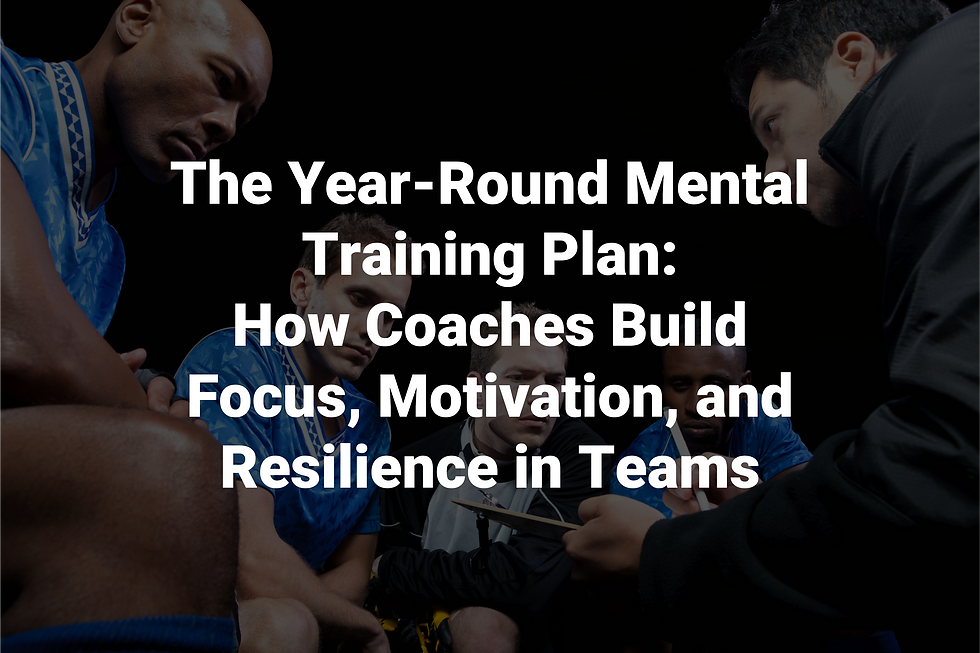What We Do
- Ben Carnes
- Mar 25, 2019
- 4 min read
Updated: Sep 8, 2022
"So what exactly do you do?" This is probably one of the most common questions I am asked when people find out that I help athletes with the mental side of their game. In its simplest form, a basic answer to that question would be:
1. HELP ATHLETES OVERCOME OBSTACLES
2. USE NEUROPSYCHOLOGY TO GIVE ATHLETES AN EDGE OVER THEIR OPPONENTS
But in reality it completely depends on where an athlete, team, or group is at and what they are trying to improve on. We use cognitive brain science to help athletes develop custom plans to be at their best when it matters the most. The athletes we work with usually fall into one of three zones:
1. Problem - I have a problem that I need to overcome so I can just get back to playing my game.
2. Default - I have no problem doing what my coach asks me to do, but I'd like to gain an edge over my opponent.
3. Elite - I am competing at a high level and I want to maximize my abilities to succeed against elite competition.

PROBLEM ZONE
Athletes who find themselves in this zone need help overcoming obstacles. That might look like a pitcher who freezes up when he walks a batter, a QB who loses confidence in himself after throwing an interception, a golfer who lets one bad shot turn into five, a basketball player who tenses up before a game winning free throw, the list goes on an on.
We offer online and in-person training to overcome these obstacles. Each situation is unique, but as a general rule we need to figure out:
1. Where is the athlete at right now in their athletic ability and career?
2. Where do they want to go, what do they want to achieve?
3. How are they going to make that a reality?
4. What obstacles ARE or COULD get in the way?
5. Teach the athlete how to control their mind and body during stressful situations.
6. Help the athlete come up with a plan do put that into action the next time that situation arises.
7. Help the athlete modify and tweak the plan to get something that fits them.
DEFAULT ZONE
One quick and easy example of how we help athletes gain an edge over their opponents would be through helping them develop a routine. Research has shown that routines have countless benefits in multiple areas of life. Some examples from our athlete's might be:
A golfer's routine to clear out their mind and relax tense muscles before a swing
A basketball player's routine to tune out the crowd and shoot a SMOOTH free throw
A pitcher having a plan to stay loose with runners in scoring position
An athlete's post competition routine to help their mind and body recover most effectively
Developing a plan to maximize interactions with coaches/parents/social media/etc. when things go well or when things go bad
ELITE ZONE
The third and final zone is all about helping athletes compete at an elite level and gain the edge over their opponents that will help them succeed at the highest level. One example would be teaching an athlete how to control their heart rate and evaluating their heart rate variable when stress is present.

In this image we have an example of an EKG printout where you can very clearly see when a "stressful" event occured and not only did the athlete's heart rate change, but their rhythm changed as well. We then completed a visualization exercise where we went through
Here is what is going to happen
Here is how your body is going to react
Here is how your mind is going to reach
Here is how you can take back control
Then we had the athlete practice the entire process in their mind. We repeated the exercise and as you can see in the second EKG printout, the athlete was able to get back to normal heart rate and normal heart rhythm MUCH faster. This athlete now has seen the proof that how he responds to stressful events will help him control his body which gives him an incredible amount of confidence the next time he takes the mound.
Another example would be using pupillometry to measure cognitive load. That is just a fancy way of saying, we can measure pupil dilation to get a good sense of how much brain power something is taking up.

Here we have an example of a quarterback that we have worked with. We used his pupil dilation while reading the word DOG as his baseline measurement. Then we had him read a complex sentence, you can see that this caused his pupil dilation to increase by 30% as he needed more brain power to complete this task. When he was asked to add 17+38 it took even more brain power and his pupil dilation went up another 15%. BUT...when he was asked to identify a Cover 2 defense on film, it went back down to somewhere between reading the word dog and a complex sentence. This simply means that this young man has watched enough film clips of this particular type of defense that he can identify it with about as much brain power as reading a few words.
This is incredibly helpful as we can now get a better grasp on how efficiently a quarterback is making his pre-snap reads. "Have you watched enough film?" is now something we can put a numerical value on to help guys make sure they feel comfortable and confident with what they are seeing from their opponents.
So what do we do?
Whatever it takes to help and athlete, team, or group achieve their goals.
-Ben




Comments